Thoughts on studio lighting
Dec 12, 2017 06:23:17 #
I agree that in Portrait mode you are probably getting a pre-flash either for exposure detection or red-eye reduction. That would trigger the strobes which would not have time to recharge before your camera fires. Full manual is the way to go.
Dec 12, 2017 08:26:40 #
crazydaddio wrote:
Good advice.
Would add...make sure you have enough distance between the subject and the background so the light falloff can occur. Even with a black background, you can get shadows or washout if there is not enough distance.
Would add...make sure you have enough distance between the subject and the background so the light falloff can occur. Even with a black background, you can get shadows or washout if there is not enough distance.
Great advice. I've done many such shoots, and have noticed that people tend to back up against the backdrop unless you tell them otherwise. I make a small mark with gaffer tape, and ask them to stand there.
Dec 12, 2017 08:33:22 #
Take a look at Robert Harrington YouTube videos on simple portrait shots as a refresher. Use your light meter if you have a handheld that will read flash output. Watch out for preflash firing your monolight pre actual shot.
Best,
Todd Ferguson
Best,
Todd Ferguson
Dec 12, 2017 09:03:43 #
I'd recommend visiting strobist.blogspot.com
--Bob
--Bob
NJphotodoc wrote:
Hi all, I've been doing photos for a local childre... (show quote)
Dec 12, 2017 09:18:41 #
rmalarz wrote:
I'd recommend visiting strobist.blogspot.com
--Bob
--Bob
Great place!
http://strobist.blogspot.com/
Dec 12, 2017 10:25:15 #
NJphotodoc
Loc: Now in the First State
Again, thanks to all for the solid and excellent suggestions. I admit I forgot about the preflash and since I was using my monolight as slave and not remote trigger it could have certainly messed things up. Will use manual and break out the Lunasix F as my go-forward strategy and let you know how it works out.
As to Crazydadio's note, the room they give me to use is only 9'x12' and has some fixed rehab items fixed to both floor and walls so my effective open floor and wall space is less than that. Not sure if I can position myself any further back than perhaps 6-7' from the subject's front and any real distance between the subject and the backdrop is really tight. Will have to live with it but any additional thoughts are always greatly appreciated. Like I said, this is a hospital so all their space is used for patient care and related issues so even getting this room has been a challenge at times.
As to Crazydadio's note, the room they give me to use is only 9'x12' and has some fixed rehab items fixed to both floor and walls so my effective open floor and wall space is less than that. Not sure if I can position myself any further back than perhaps 6-7' from the subject's front and any real distance between the subject and the backdrop is really tight. Will have to live with it but any additional thoughts are always greatly appreciated. Like I said, this is a hospital so all their space is used for patient care and related issues so even getting this room has been a challenge at times.
Dec 12, 2017 11:12:01 #
NJphotodoc
Loc: Now in the First State
Again, thanks to all for the solid and excellent suggestions. I admit I forgot about the preflash and since I was using my monolight as slave and not remote trigger it could have certainly messed things up. Will use manual and break out the Lunasix F as my go-forward strategy and let you know how it works out.
As to Crazydadio's note, the room they give me to use is only 9'x12' and has some fixed rehab items fixed to both floor and walls so my effective open floor and wall space is less than that. Not sure if I can position myself any further back than perhaps 6-7' from the subject's front and any real distance between the subject and the backdrop is really tight. Will have to live with it but any additional thoughts are always greatly appreciated. Like I said, this is a hospital so all their space is used for patient care and related issues so even getting this room has been a challenge at times.
As to Crazydadio's note, the room they give me to use is only 9'x12' and has some fixed rehab items fixed to both floor and walls so my effective open floor and wall space is less than that. Not sure if I can position myself any further back than perhaps 6-7' from the subject's front and any real distance between the subject and the backdrop is really tight. Will have to live with it but any additional thoughts are always greatly appreciated. Like I said, this is a hospital so all their space is used for patient care and related issues so even getting this room has been a challenge at times.
Dec 12, 2017 15:54:09 #
I've had a bunch of books on studio photography and they've been almost useless. I finally found these books by photographer Christopher Grey. They're a gold mine of information. He gives information that can really be used. I've read almost all of the chapters. You can do a "Look Inside" on Amazon. Here are the four books of his that I purchased:
Studio Lighting Techniques For Photography
Lighting Techniques For Beauty And Glamour Photography
Advanced Lighting Techniques
Master Lighting Guide for Portrait Photographers
Studio Lighting Techniques For Photography
Lighting Techniques For Beauty And Glamour Photography
Advanced Lighting Techniques
Master Lighting Guide for Portrait Photographers
Dec 12, 2017 16:52:50 #
amfoto1
Loc: San Jose, Calif. USA
Okay, first... Are you shooting head and shoulder portraits... with the lighting pretty close (6 or 8 feet) from the subject(s)? If so, you MIGHT have just barely enough lighting. You don't really have enough lighting to do full length standing portraits or small groups of people without using a high ISO.
For one thing, a flash like your SD700 is much less powerful than a studio strobe such as your other light (which is also pretty low powered). I would guess it's equiv. to about 150 or 200 ws at most. At least you're using it directly, albeit through a diffuser, not trying to bounce it off a ceiling or out of an umbrella which would waste a lot of the light.
My "location" lighting rig is five monolights, two 48" umbrellas, three stands, a boom stand and a 9 foot wide backdrop with seamless paper and cloth rolls in various colors.
I usually set up my main light with two 320 ws monolights ganged up in one of the umbrellas off to one side and use a single 320 ws monolight in the other umbrella on the opposite side as a fill light. Both the umbrellas are typically set 12 to 15 feet from the subject. The two remaining monolights can be optionally used various ways.... possibly to light the background or on the boom above and slightly behind the subjects, pointed downward as a "hair light". Whenever possible I set the main and fill lights to 1/2 power, the hair light to 1/4 power and if I'm using it, the background light to 1/4 or 1/2 power depending upon the color of the background and the intensity I want. The reason I reduce power is to make for faster recycling (1 or 2 seconds versus 3 or 4 seconds per shot).
I usually don't use portable flash along with the monolights, but I have six 190 gn flashes that can be used if needed, for a larger space or to illuminate a more distant background, etc.
For example, my main light (dual 320 ws monolights, 48" umbrella, 1/2 power) and fill light (single monolight, 48" umbrella), both about 12 or 13 feet from the subjects, gives me marginally enough light for the following (at ISO 100):
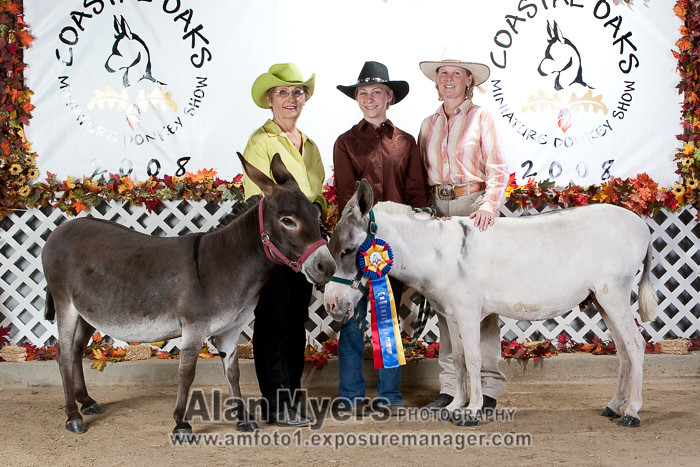
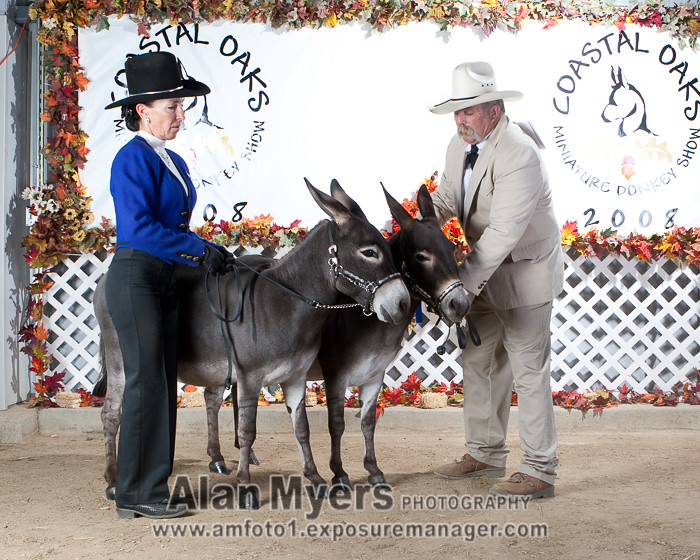
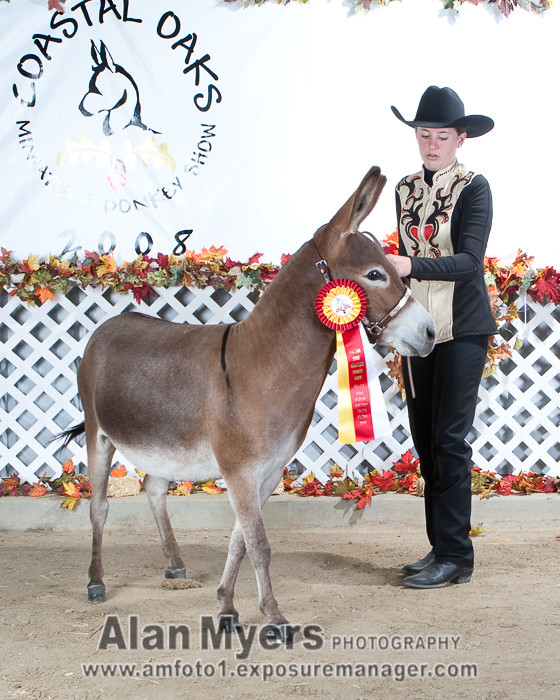
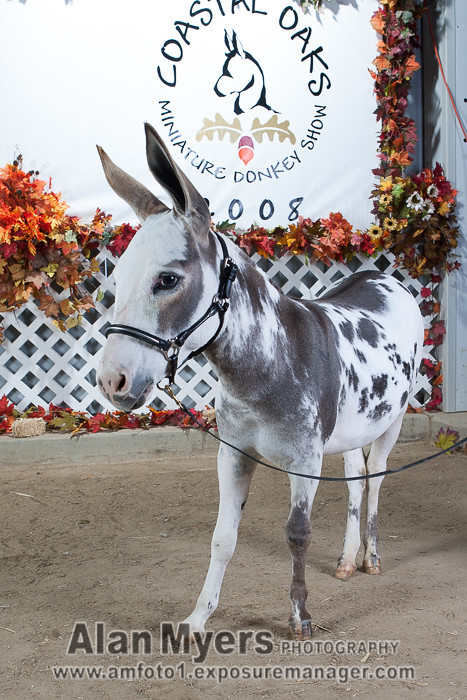
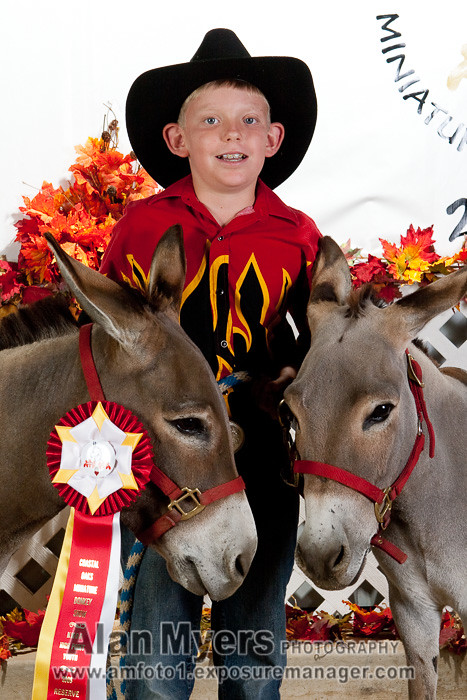
(BTW: Miniature donkeys are TONS OF FUN to photograph! The above are posed/awards shots. Action shots, done without flash so not relevant to this topic, are another thing entirely.)
My single most useful thing when working with lighting like above is a handheld flash meter. I use a Sekonic L358 now, but also have Minolta IV and III that I've used in the past (and keep as backups). This allows me to pretty quickly establish all my exposure settings. A few test shots and some minor tweaks to settings or adjustments to the lights, and I'm all ready to shoot.
Finally... I ALWAYS set my camera to fully manual. I'd wager much of the exposure problems you're having are because you're trying to use Auto and Exposure Compensation (or ESPECIALLY a "super auto" mode like "Portrait"). When your lighting is set up, you've metered it and dialed in the exposure as described, there's no need for automation. Every exposure should be exactly the same. The best way to do that is to set the camera to fully Manual (including turning off Auto ISO, if you use it). This "locks everything down" and avoids the automation skewing your settings for various reasons.
At the event in the photos above, I was working with two Canon cameras myself, as well as a second photographer who was using a pair of Nikons. Once we'd determined them we simply made note of the manual settings on a white board and used the same for all our cameras, with good success, over the course of two days. We were going back and forth from shooting action without flash and with high ISO/auto exposure to shooting the posed shots with the lighting gear, low ISO and manual exposure. It was simple enough to reset our cameras each time we went from one to the other. The only problem we had was that at the time I was using optical triggering with the monolights and other people's flashes kept setting them off... spoiling some exposures (I've since put together a radio/wireless setup that avoid that problem).
Below shows what happens when only one of your lights goes off (the other fired early or was still recycling because someone set if off with their camera's flash):

For one thing, a flash like your SD700 is much less powerful than a studio strobe such as your other light (which is also pretty low powered). I would guess it's equiv. to about 150 or 200 ws at most. At least you're using it directly, albeit through a diffuser, not trying to bounce it off a ceiling or out of an umbrella which would waste a lot of the light.
My "location" lighting rig is five monolights, two 48" umbrellas, three stands, a boom stand and a 9 foot wide backdrop with seamless paper and cloth rolls in various colors.
I usually set up my main light with two 320 ws monolights ganged up in one of the umbrellas off to one side and use a single 320 ws monolight in the other umbrella on the opposite side as a fill light. Both the umbrellas are typically set 12 to 15 feet from the subject. The two remaining monolights can be optionally used various ways.... possibly to light the background or on the boom above and slightly behind the subjects, pointed downward as a "hair light". Whenever possible I set the main and fill lights to 1/2 power, the hair light to 1/4 power and if I'm using it, the background light to 1/4 or 1/2 power depending upon the color of the background and the intensity I want. The reason I reduce power is to make for faster recycling (1 or 2 seconds versus 3 or 4 seconds per shot).
I usually don't use portable flash along with the monolights, but I have six 190 gn flashes that can be used if needed, for a larger space or to illuminate a more distant background, etc.
For example, my main light (dual 320 ws monolights, 48" umbrella, 1/2 power) and fill light (single monolight, 48" umbrella), both about 12 or 13 feet from the subjects, gives me marginally enough light for the following (at ISO 100):





(BTW: Miniature donkeys are TONS OF FUN to photograph! The above are posed/awards shots. Action shots, done without flash so not relevant to this topic, are another thing entirely.)
My single most useful thing when working with lighting like above is a handheld flash meter. I use a Sekonic L358 now, but also have Minolta IV and III that I've used in the past (and keep as backups). This allows me to pretty quickly establish all my exposure settings. A few test shots and some minor tweaks to settings or adjustments to the lights, and I'm all ready to shoot.
Finally... I ALWAYS set my camera to fully manual. I'd wager much of the exposure problems you're having are because you're trying to use Auto and Exposure Compensation (or ESPECIALLY a "super auto" mode like "Portrait"). When your lighting is set up, you've metered it and dialed in the exposure as described, there's no need for automation. Every exposure should be exactly the same. The best way to do that is to set the camera to fully Manual (including turning off Auto ISO, if you use it). This "locks everything down" and avoids the automation skewing your settings for various reasons.
At the event in the photos above, I was working with two Canon cameras myself, as well as a second photographer who was using a pair of Nikons. Once we'd determined them we simply made note of the manual settings on a white board and used the same for all our cameras, with good success, over the course of two days. We were going back and forth from shooting action without flash and with high ISO/auto exposure to shooting the posed shots with the lighting gear, low ISO and manual exposure. It was simple enough to reset our cameras each time we went from one to the other. The only problem we had was that at the time I was using optical triggering with the monolights and other people's flashes kept setting them off... spoiling some exposures (I've since put together a radio/wireless setup that avoid that problem).
Below shows what happens when only one of your lights goes off (the other fired early or was still recycling because someone set if off with their camera's flash):

Dec 12, 2017 17:17:07 #
amfoto1
Loc: San Jose, Calif. USA
jmizera wrote:
...I make a small mark with gaffer tape, and ask them to stand there.
Good suggestion!
You also might want to mark the location of each light, plus where you should stand with the camera, just in case things get moved. With manual lighting, for repeatable accuracy, it's all about keeping distances the same, as well as your camera, flash and lighting settings!
Dec 12, 2017 18:30:03 #
NJphotodoc wrote:
Hi all, I've been doing photos for a local childre... (show quote)
You can post photos if you blur the faces. >alan
If you want to reply, then register here. Registration is free and your account is created instantly, so you can post right away.






